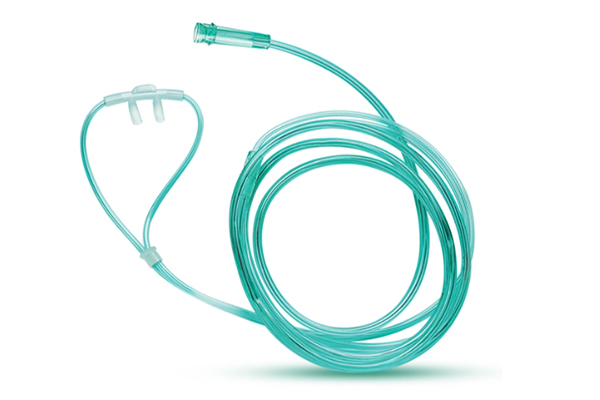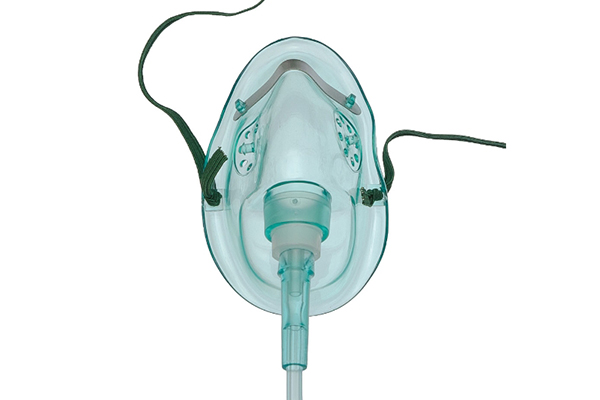When you or a loved one needs extra help breathing, understanding the tools used to deliver oxygen is crucial. This article explains the common devices like nasal cannulas and oxygen masks, breaking down how they work and when they’re used. Learning about these essential tools can make managing oxygen therapy less daunting and more effective.
What Exactly is a Nasal Cannula, and How Does it Work?
A nasal cannula is a simple and commonly used oxygen device to deliver oxygen to someone who needs supplemental oxygen. Imagine two small, soft prongs that gently fit into your nostril. These prongs are connected to tubing that connects to an oxygen source, like an oxygen concentrator or oxygen tanks. The flow of oxygen travels through the tubing and into your nasal passages, helping you get more oxygen into your lungs. Nasal cannulas are often used for individuals who need a lower amount of supplemental oxygen.
Think of it like a gentle breeze of extra air. The nasal cannula is designed to provide a comfortable and convenient way to increase the oxygen levels in your body. Because it only sits in the nose and mouth is free, you can still talk, eat, and drink while receiving oxygen therapy. This makes it a popular choice for many people who need supplemental oxygen.
How Do You Use a Nasal Cannula Effectively to Get the Most Benefit?
To use a nasal cannula effectively, make sure the two prongs are comfortably placed inside your nostril. The tubing usually wraps around your ears to keep the nasal cannula in place. Your doctor will prescribe a specific flow rate, measured in liters of oxygen per minute, which you’ll set on your oxygen source. It’s important to keep your oxygen source positioned safely and avoid kinks in the tubing to ensure a consistent oxygen supply.
Proper care of your nasal cannula is also important. Clean the nasal prongs regularly as instructed by your healthcare provider to prevent infection. Make sure the tubing is not twisted or blocked, as this can reduce the flow of oxygen. By following your doctor’s instructions and taking good care of your nasal cannula, you can ensure you’re getting the oxygen you need to breathe easier. Remember, the goal is to get enough oxygen to your lungs so your body can function properly.
What is Low Flow Oxygen Delivery with a Nasal Cannula?
Low flow oxygen delivery with a nasal cannula typically refers to flow oxygen rates between 1 and 6 liters of oxygen per minute. This method is suitable for individuals who may otherwise need supplemental oxygen but don’t require very high oxygen concentrations. The nasal cannula mixes the flow oxygen with the room air you breathe. Because of this mixing, the exact percentage of oxygen you receive isn’t precisely controlled but is generally effective for many patients with conditions like COPD or certain cardiac diseases.
Many people wonder if low flow is enough. For many, it is! The beauty of low flow oxygen via a nasal cannula is its simplicity and comfort. It allows for greater freedom of movement compared to other oxygen delivery systems. Your doctor will determine if low flow is appropriate for your specific needs based on your oxygen levels and overall health. This is a common way to manage home oxygen therapy.
When is a Mask or Face Mask a Better Choice Than a Nasal Cannula to Flow Oxygen?
While nasal cannulas are great for low flow oxygen, a mask or face mask becomes necessary when someone needs higher concentrations of oxygen. There are several different types of oxygen masks. A simple face mask covers both the nose and mouth and allows for slightly higher flow rates than a nasal cannula. Oxygen masks are designed to create a better seal around the nose and mouth, reducing the mixing of room air and delivering a more precise oxygen supply.
For individuals in respiratory distress or who may undergo certain medical procedures, oxygen masks like partial rebreather or oxygen non-rebreathing masks might be used. These masks have reservoirs that store oxygen, allowing for even higher concentrations to be delivered. When the need for oxygen increases, or when a consistent and higher percentage of oxygen is crucial, masks deliver oxygen to patients more effectively than a nasal cannula. Understanding the nuances of nasal cannulas and oxygen face masks helps healthcare providers choose the best device used.

What is High Flow Oxygen and When is it Necessary?
High flow oxygen delivery goes beyond the capabilities of a standard nasal cannula or simple face mask. A high-flow nasal cannula (HFNC) can deliver warmed and humidified oxygen at much high flow rates, sometimes up to 60 liters of oxygen per minute. This method is often used for patients in respiratory distress who need significant respiratory support. HFNC can help improve breathing mechanics and reduce the work of breathing.
Think of it as a more powerful and supportive way to get oxygen to patients in respiratory failure. High flow oxygen helps to flush out carbon dioxide from the nasal passages and provides a consistent and precise oxygen supply. This type of therapy is typically administered in a hospital setting where close monitoring is possible. While a standard nasal cannula provides supplemental oxygen, high flow oxygen offers a more intensive level of respiratory assistance.
Is it Safe to Use a Nasal Cannula at Home? What Precautions Should I Take?
Yes, it is generally safe to use a nasal cannula at home if it’s prescribed by your doctor and you follow their instructions carefully. However, there are important precautions to take. Oxygen is highly flammable and could cause a fire if not handled properly. Keep your oxygen source away from open flames and heat sources. Make sure everyone in the household knows that oxygen is highly flammable and to avoid smoking or using lighters nearby.
It’s also important to have a plan in case of a power outage, especially if you rely on an oxygen concentrator. Talk to your healthcare provider about backup oxygen supply options, such as oxygen tanks. Regularly check the tubing for kinks or blockages, and ensure the nasal cannula fits comfortably and securely. By being mindful and following safety guidelines, you can safely and effectively manage your home oxygen therapy with a nasal cannula.

What are the Differences Between Low Flow Oxygen and High Flow Oxygen Delivery Methods?
The primary difference between low flow oxygen and high flow oxygen delivery methods lies in the amount of oxygen delivered per minute and the level of respiratory support provided. Low flow oxygen, typically delivered via a standard nasal cannula or simple face mask, provides supplemental oxygen at rates up to around 6 liters of oxygen per minute. The oxygen concentrations achieved with low flow can vary depending on the person’s breathing pattern.
High flow oxygen, usually delivered through a high-flow nasal cannula (HFNC), can deliver much higher flow rates, often up to 60 liters of oxygen per minute. This allows for more precise control over the oxygen concentrations and provides additional benefits like warming and humidifying the air, which can be more comfortable and beneficial for the respiratory system. High flow provides greater respiratory support and is often used for more acute respiratory issues, while low flow is typically used for stable, chronic conditions.
How Does an Oxygen Concentrator Work with These Devices to Provide an Oxygen Source?
An oxygen concentrator is a medical device that takes room air, filters out the nitrogen, and provides a concentrated oxygen source. Unlike oxygen tanks that need to be refilled, an oxygen concentrator continuously produces oxygen as long as it’s plugged into a power source. For nasal cannulas, the tubing from the cannula connects to an oxygen outlet on the oxygen concentrator. The flow rate is then adjusted on the oxygen concentrator according to your doctor’s prescription.
Similarly, oxygen masks also connect to the oxygen concentrator in the same way. The oxygen concentrator is a vital piece of equipment for many people who require home oxygen therapy, as it provides a convenient and reliable oxygen supply. It makes managing oxygen therapy at nasal cannula at home much easier and more sustainable.
<img src="https://sccdn.sechitech.com/medicalzx/uploads/connecting-tube.jpg" alt="Suction Connecting Tube" width="300">What are the Pros and Cons of Using a Nasal Cannula Versus a Face Mask?
Choosing between a nasal cannula vs a face mask depends on individual needs and the required level of oxygen delivery. Nasal cannulas are generally more comfortable and allow for eating, drinking, and talking without interruption. They are suitable for low flow oxygen and are less likely to cause feelings of claustrophobia. However, they are less effective at delivering higher concentrations of oxygen.
Face masks, on the other hand, can deliver higher concentrations of oxygen and are more effective for individuals who breathe through their mouths. However, they can feel more restrictive and may interfere with eating and speaking. Masks can also sometimes lead to feelings of being enclosed. Ultimately, the pros and cons need to be weighed based on the specific medical needs and comfort of the individual. Your doctor will help determine which oxygen device is best for you.
Where Can You Find High-Quality Nasal Cannulas and Oxygen Masks?
Finding reliable nasal cannulas and oxygen masks is crucial for effective oxygen therapy. As a leading Professional Medical Device Manufacturer – ZhongXing, we understand the importance of quality and reliability in medical consumables. Our range includes necessities like nasal cannulas, various types of oxygen masks, and other essential respiratory care products. We offer high-quality medical-grade materials, ensuring both sterile and non-sterile options are available to meet diverse needs.
Our products, including our durable and comfortable Medical cotton swab 7.5CM disposable, our reliable *Disposable gauze swab 40S 1915mesh folded edge, and our essential Medical bed sheet, are designed with patient comfort and safety in mind. We proudly export our products to the USA, North America, Europe, and Australia, serving hospitals, clinics, and medical distributors. We also offer vital Surgery Supplies such as Sterile suture with needle and Medical Suction Connecting Tube 1.8mm With Yankuer. For all your nasal cannulas and oxygen needs, consider a trusted manufacturer committed to quality. You can explore our range of nasal cannulas and oxygen face** masks on our website.
<img src="https://sccdn.sechitech.com/medicalzx/uploads/cotton-swabs.jpg" alt="Medical Cotton Swabs" width="300">Key Takeaways:
- Nasal cannulas are ideal for delivering low flow oxygen and are comfortable for everyday use.
- Oxygen masks are necessary for delivering higher concentrations of oxygen.
- High flow oxygen via HFNC provides significant respiratory support for patients in respiratory distress.
- Safety precautions are crucial when using oxygen at home due to its flammability.
- Oxygen concentrators offer a convenient and continuous oxygen source.
- Choosing between a nasal cannula and a face mask depends on individual needs and the prescribed flow rate.
- Reliable suppliers like ZhongXing provide high-quality nasal cannulas and oxygen masks.
Remember to always consult with your healthcare provider to determine the best oxygen therapy method and device for your specific condition. They can provide guidance on proper usage and safety precautions to ensure you receive the maximum benefit from your supplemental oxygen.
Post time: 1月-20-2025





